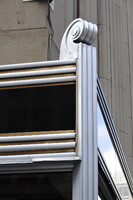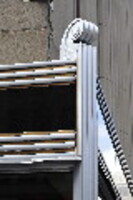| dc.coverage.spatial | Site: New York, New York, United States | en_US |
| dc.coverage.temporal | 1930-1931 (creation); 2010 (restoration) | en_US |
| dc.creator | Shreve, Lamb & Harmon | en_US |
| dc.date | 1930-1931 | en_US |
| dc.date.accessioned | 2013-12-18T21:17:24Z | |
| dc.date.available | 2013-12-18T21:17:24Z | |
| dc.date.issued | 1930-1931 | en_US |
| dc.identifier | 241782 | en_US |
| dc.identifier.other | archrefid: 227 | en_US |
| dc.identifier.uri | http://hdl.handle.net/1721.3/150071 | |
| dc.description | Pathway between enclosure all on the right and the tower area, with pergola arching overhead; Until outstripped by the twin towers of the World Trade Center (1975), its 102 floors were the highest in New York. Though designed at the end of the so-called Art Deco period in the 1920s, when zigzagged appliqués were prominent, its exterior shows little of the frippery characteristic of that decorated period. It is, moreover, one of the very few skyscrapers with four facades, not just one facing the avenue. Zoning required several setbacks, but these were given a skillful buildup of scale at the lower levels, while the tower itself rises unflinchingly. Indented setbacks in the center of each of the long sides help lateral scale. An observation platform and a pylon topped by a television transmission antenna crown all. The Empire State Building, like most Art Deco skyscrapers, was modernistic, not modernist. It was deliberately less pure, more flamboyant and populist than European theory allowed. It appeared to be a sculpted or modeled mass, giving to business imagery a substantial character...[Great Buildings] It was constructed in only 14 months. William Lamb, principal architect. There is an open observation deck on the 86th floor and a smaller completely enclosed deck on the 102nd floor. Source: Great Buildings Collection; http://www.greatbuildings.com (accessed 12/2/2007) | en_US |
| dc.format.medium | steel; Indiana limestone; granite; marble; aluminum | en_US |
| dc.rights | © Scott Gilchrist, Archivision, Inc. | en_US |
| dc.subject | architectural exteriors | en_US |
| dc.subject | business, commerce and trade | en_US |
| dc.subject | Art Deco | en_US |
| dc.subject | Twentieth century | en_US |
| dc.title | Empire State Building | en_US |
| dc.type | image | en_US |
| dc.rights.access | Licensed for educational and research use by the MIT community only | en_US |
| dc.identifier.vendorcode | 1A1-SLH-ES-D35 | en_US |
| vra.culturalContext | American | en_US |
| vra.technique | construction (assembling) | en_US |
| vra.worktype | office building | en_US |
| vra.worktype | skyscraper | en_US |
| dc.contributor.display | Shreve, Lamb & Harmon (American architectural firm, renamed 1929) | en_US |



